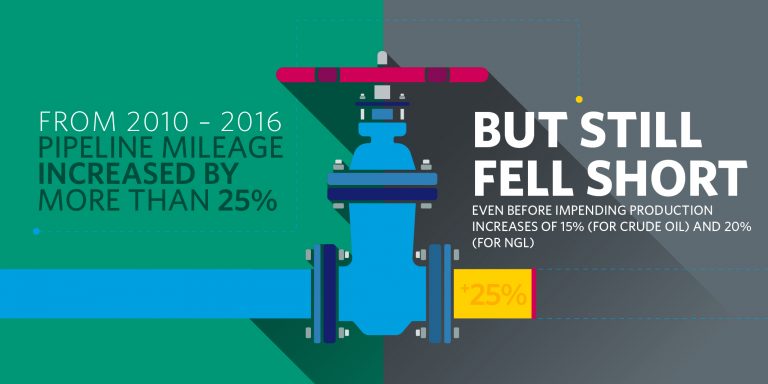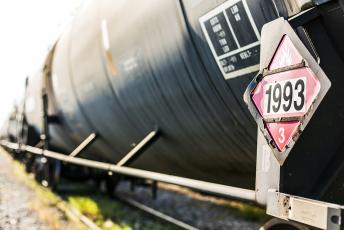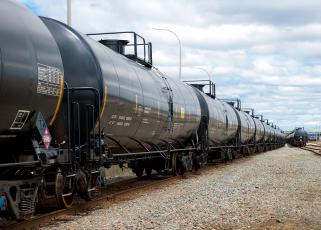U.S. refiners and petrochemical manufacturers were encouraged on April 10 when President Trump signed an executive order that will better clarify the roles of federal and state agencies in permitting decisions for energy infrastructure, including oil and natural gas pipelines. The move will, in the words of the president, “dramatically accelerate” the decision-making process surrounding approvals, and ultimately promote investment in critical infrastructure projects that help transport oil and natural gas feedstocks from upstream production fields to refineries and petrochemical manufacturing facilities.
Developments like this have been sorely needed for some time. With booming U.S. production of crude oil and natural gas liquids (NGLs), refiners have  steadily increased their processing of domestic crude supply. As a result, they are increasingly reliant on pipelines for their feedstocks. U.S. petrochemical manufacturers are thriving as well, expanding existing capacity and building new plants to process increasing supplies of NGLs. Unfortunately, pipeline development has failed to keep pace.
steadily increased their processing of domestic crude supply. As a result, they are increasingly reliant on pipelines for their feedstocks. U.S. petrochemical manufacturers are thriving as well, expanding existing capacity and building new plants to process increasing supplies of NGLs. Unfortunately, pipeline development has failed to keep pace.
For example: in 2016, U.S. refineries received 10.2 million barrels per day of crude oil via pipeline, and 62 percent of total crude receipts, an increase in refinery pipeline receipts of more than 30 percent since 2010 — and, U.S. refinery pipeline receipts have continued to increase in the last two years. From 2010 to 2016, crude oil and NGL pipeline mileage increased by more than 25 percent, but this was outpaced by rising productions levels.
Fast forward to 2019 and beyond: with U.S. oil and NGL production projected to grow by more than 15 percent and 20 percent, respectively, over the next decade, significant new investments are needed to ensure that these resources can be tapped by U.S. refiners and petrochemical manufacturers to fuel our growing economy.
As the United States’ energy renaissance continues and oil and natural gas production breaks new records, the need for government policies, like the clear and timely decision-making processes enabled by the president’s recent executive orders, that support the expansion of midstream infrastructure development is growing. This infrastructure is vital to ensuring Americans continue to reap the benefits of the shale revolution, which include access to reliable and affordable fuel, as well as petrochemical feedstocks.
Refiners and petrochemical makers are poised to invest billions into new pipelines, ports and storage facilities, and support the ongoing construction and maintenance of railroads, highways and waterways to ensure a healthy supply chain and alleviate bottlenecks. But our industries will continue to need the support of policymakers through consistent, commonsense government regulation.
The need for infrastructure investment is a concern shared across the political spectrum and by experts inside and outside the industry. Here’s what they’re saying:
Media
- “The uncertainty around permitting pipelines comes as U.S. natural gas production shows little sign of slowing down, as hydraulic fracturing continues to unlock shale gas deposits from Texas to Pennsylvania.” – James Osborne, Reporter, Houston Chronicle, 2/13/19
- “[A] crude-by-rail comeback is expected to last … in North Dakota and Canada, as companies struggle to lay new pipe as quickly as drillers are getting oil out of the ground.” – Rebecca Elliot, Reporter, Wall Street Journal, 1/31/19
- “Pipeline shortages in West Texas, which forced producers to deeply discount crude in the Midland market, spurred a 25 percent increase in the number of uncompleted wells in 2018.” – Jordan Blum, Energy Reporter, Houston Chronicle, 1/14/19
- “Without improvements to port facilities, the U.S. crude oil market could find itself increasingly landlocked…The United States is now an oil exporter, though infrastructure necessary to move the oil to the market can’t keep up with production trends.” – Daniel Gaeber, Reporter, UPI, 6/18/18
Industry Experts
- “Despite a 140 percent boom in U.S. crude oil production and a 50 percent jump in natural gas output since shale took flight in 2008, the midstream infrastructure to pipe this new supply around the country has simply not kept up. This is a major problem for us because pipelines are easily the safest and most economical way to transport energy.” – Jude Clemente, Contributor, Forbes, 1/28/19
- “Without a business and regulatory climate that… accommodates the pipeline infrastructure development required to attract additional investment to Southeast Pennsylvania, the area may well remain unattractive to major investors for future projects.” – David Taylor, President & CEO, Pennsylvania Manufacturers Association, 1/15/19
- “Infrastructure takes a lot more time than the market typically expects… When export terminal capacity is maxed out, U.S. oversupply gets trapped in storage onshore…” – J. Alexander Blackman, Senior Executive, Standard Delta LLC, 10/21/18
- “In recent years, chemical transportation has become a significant concern for manufacturers, driven by regulations, congestion issues, and increasing costs…Given the current challenges already present in the transportation network, chemical manufacturers will face additional transportation-related costs as industry shipments increase.” – PwC, Transporting Growth: Delivering a Chemical Manufacturing Renaissance, 3/17
Government Officials/Policymakers
- “It’s clear that infrastructure development must be a priority in 2019. Yet, that’s not what we have seen in the bayous of Louisiana or the plains of the Dakotas…The U.S. faces complex infrastructure deficiencies that are undoubtedly multi-faceted and will take some time to improve. These matters will not be solved overnight; or within the next year, for that matter.” – Former Rep. Charlie Melancon (D-LA), The Hill, 2/7/19
- “The number one economic focus on my office today is the natural gas hub.” Storage is a key infrastructure investment needed to attract petrochemical manufacturers to the region. “[T]he hub ensures a job boom in West Virginia forever. It ensures our security forever, the way I see it. Forever.” – Jim Justice, Governor of West Virginia, to West Virginia Public Radio, 1/23/19
- “Today’s consumers have more choices, more information, more say on their energy sources than ever before… If we’re to seize this amazing moment in American energy, it is imperative we build more energy infrastructure.” Rick Perry, U.S. Secretary of Energy, 11/29/18
- “We need infrastructure, including pipelines… We need east to west, we need west to east.” Larry Kudlow, Director of the U.S. National Economic Council, 10/4/18
- “We need investment in energy transportation infrastructure like pipelines and ports to realize Texas’ full potential.” Ryan Sitton, Commissioner, Texas Railroad Commission, 5/7/18


